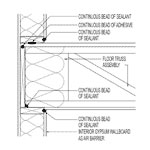Recorded at the demonstration stage at NESEA’s Building Energy 13 conference in Boston on March 6, 2013, two representatives from National Fiber, Bill Hulstrunk and Chris White, share the tips for installing dense-packed cellulose in wall cavities.
Cellulose insulation is made from recycled newspaper. When installed at a density of 3.5 pounds per cubic foot, it has an R-value of about R-3.6 or R-3.7 per inch.
Among the questions answered in this video:
- What tool is best for cutting InsulWeb fabric — scissors or a utility knife?
- What’s the best tool for stapling InsulWeb?
- What’s the maximum recommended spacing between staples?
- What are the minimum specs for an air compressor used to power a pneumatic stapler?
- What is lip stitching, and when is it necessary?
- What tool is used to make a hole in the InsulWeb when it’s time to insert your cellulose tube?
- Where do you aim your tube first when you begin filling an empty stud cavity with cellulose?
- How can you tell when the cellulose has achieved 3.5 pounds per cubic foot density?
- What do you do if the insulation bellies out and stands proud of the studs?
- Does damp-sprayed cellulose have any advantages over dry dense-packed cellulose?
- How can you tell whether damp-spray cellulose was installed with too much water?
- If studs are spaced 24 inches on center, is it still possible to install cellulose insulation behind InsulWeb?
OTHER VIDEOS FROM THE NESEA CONFERENCE
Video: Duct Sealing and Leak Testing
EDITOR’S PICKS
How to Install Cellulose Insulation
GBA Encyclopedia: Blown-In or Loose-Fill Insulation
Alex Wilson: Cellulose Insulation
How to Build an Insulated Cathedral Ceiling
Product Guide: Blown Insulation







0 Comments
Log in or create an account to post a comment.
Sign up Log in